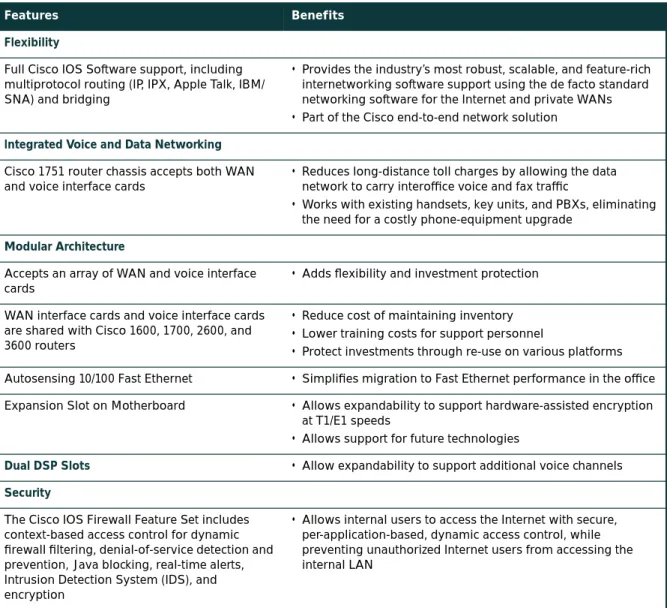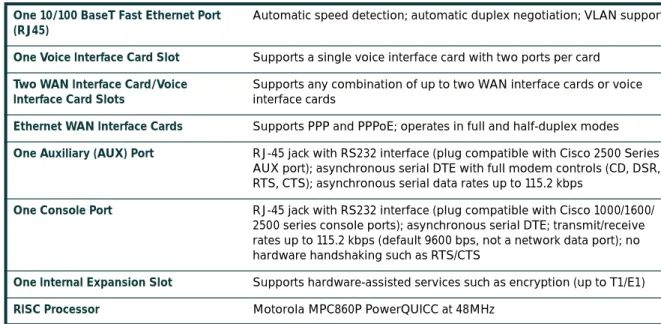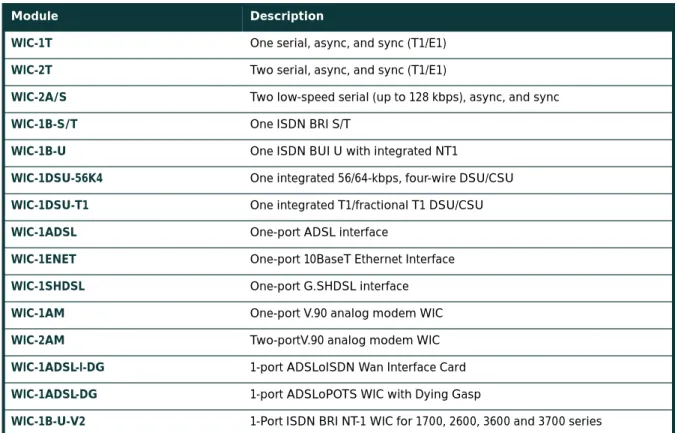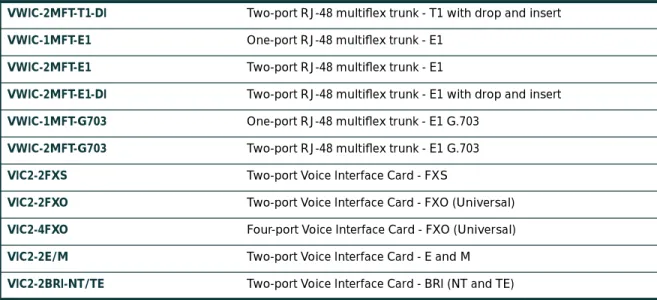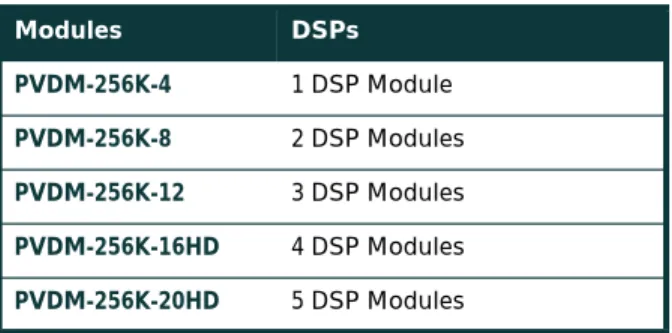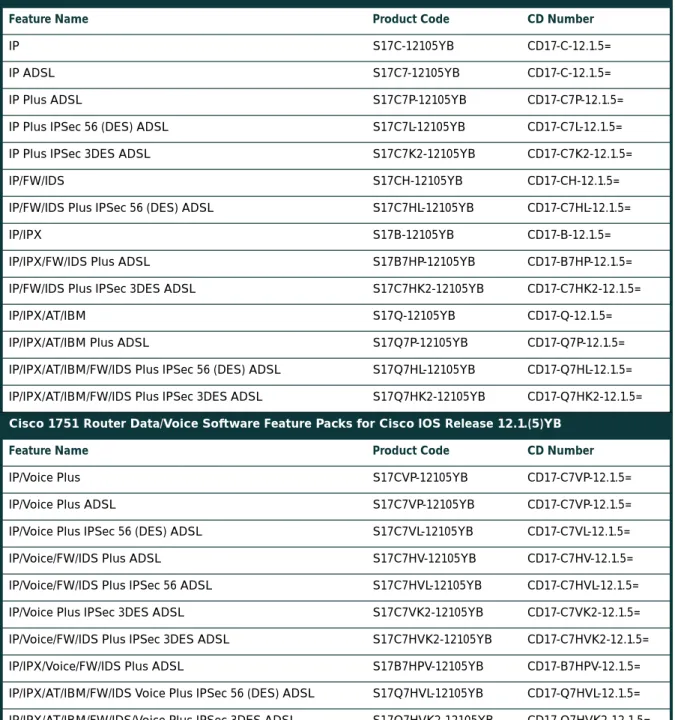Data Sheet
Cisco
1751
Modular Access Router
Figure 1 The Cisco 1751 Router delivers a versatile e-Business WAN access solution.
Cisco 1751 Modular Access Router is ideally suited to help you evolve your organization into an e-Business. It supports e-Business features such as VPNs; secure Internet, intranet, and extranet access with optional firewall technology; broadband DSL and cable connectivity; and multiservice voice/video/data/fax integration. The Cisco 1751 Modular Access Router offers:
• Flexibility to adapt to changing requirements
• Modularity that allows you to individually configure the system to meet specific business needs
• Investment protection with features and performance to support new WAN services such as broadband DSL and cable access, multiservice voice/data integration, and VPNs
• Integration of multiple network functions, including an optional firewall VPN, and data service unit/channel service unit (DSU/CSU) to simplify deployment and management
The Cisco 1751 Router delivers these capabilities with the power of Cisco IOS Software in a modular integrated access solution. The Cisco 1751 Router provides a cost-effective solution to support e-Business applications through a comprehensive feature set including support for:
• Multiservice voice/fax/data integration • Secure Internet, intranet, and extranet
access with VPN and firewall
• Integrated broadband DSL connectivity • VLAN support (IEEE 802.1Q)
The Cisco 1751 Router, a member of the Cisco 1700 Family, features a modular architecture that enables cost-effective upgrades and additions of WAN and voice interfaces. Integrated network services and functions, such as optional firewall, DSU/ CSU, and VPN features, reduce the complexity of deploying and managing e-Business solutions. The Cisco 1751 Router offers investment protection when your business needs it, with a RISC architecture and features to support new technologies and applications such as voice/ video/data/fax integration and VPNs. See Figure 2.
Figure 2
Cisco 1751 Routers provide all necessary capabilities to connect to the Internet and communicate with vendors, customers, and other employees and offices.
The Cisco 1751 Router is available in two models that enable you to easily tailor an access solution to suit your e-Business requirements today and in the future. See Table 1.
All Cisco 1751 models offer three modular slots for voice and data interface cards, an autosensing 10/100BaseT Fast Ethernet LAN port supporting standards-based IEEE 802.1Q VLAN, a console port, and an auxiliary port. The Cisco 1751 Router supports the same WAN interface cards as the Cisco 1600, 1700, 2600, and 3600 Series routers, and the same voice interface cards and voice-over-IP (VoIP) technology as the Cisco 1700, 2600, and 3600 Series routers. This simplifies support requirements. The WAN interface cards support a wide range of services, including Table 1 The Cisco 1751 Modular Access Router
Cisco 1751 Base Model
Includes everything an office needs for data networking now (32 MB Flash, 64 MB DRAM, and Cisco IOS IP software feature set), with a simple upgrade path to full voice functionality. WAN interface cards are available separately.
Cisco 1751-V Multiservice Model
Includes all the features needed for immediate integration of data and voice services with support for up to two voice channels (32 MB Flash and 96 MB DRAM, one DSP (PVDM-256K-4), and Cisco IOS IP Plus Voice feature set). Voice and WAN interface cards are available separately. Agents E-Business Application and Web Servers Telecommuter/ Branch Office Cisco 1751
Series Router with Cisco IOS Firewall
Cisco 1751 SerCisco IOith Cisco IOS Firewall
Internet Service Provider with Hosted E-Mail Service Fax ISDN/DSL/T1/FR VPN Tunnels ISP Internet Customers Supplier Router with Router with
and serial with DSU/CSU options for primary and backup WAN connectivity. The voice interface cards support Foreign Exchange Office (FXO), Foreign Exchange Station (FXS), Network and User Side Voice BRI (ISDN BRI NT/ TE), Ear & Mouth (E&M), direct inward dial (DID), and T1/E1 Multiflex VWICs. Additionally, an Ethernet interface card provides the Cisco 1751 Router with dual-Ethernet capability to support the external broadband modem devices. See Figure 3.
Figure 3
Cisco 1751 Router Incorporating Ethernet WAN Interface Card (WIC) Deployed with Broadband Modem
In addition, dual-Ethernet capability on the Cisco 1751 Router enables the creation of perimeter/DMZ (demilitarized zone) LANs to enhance security by physically separating private and public data. See Figure 4.
Figure 4
Cisco 1751 Router Incorporating Ethernet WIC to Deploy Perimeter/DMZ LAN
Combined, these interfaces support a comprehensive set of applications, including multiservice voice/video/data/fax integration, Frame Relay, ISDN BRI, SMDS, X.25, broadband DSL and cable services, and VPNs.
Internet
LAN DSL/Cable
Modem
Cisco 1751 Router with Cisco IOS Firewall
and Dual-Ethernet Internet LAN Segment DMZ LAN Private LAN Web Servers Cisco 1751 Router with
Cisco IOS Firewall and Dual-Ethernet T1
Key Benefits
The Cisco 1700 Series routers support the value of end-to-end Cisco network solutions with the following benefits:
Flexibility—The modular Cisco 1751 Router adapts easily to fit the needs of growing businesses. Interchangeable
WAN interface cards enable easy additions or changes in WAN technologies without requiring a forklift upgrade of the entire platform. Modular data and voice slots enable users to tailor data and voice services as needed. With the ability to use the same field-upgradable WAN and voice interface cards across multiple Cisco access router platforms, the Cisco 1751 Router reduces requirements for spare parts inventory and support training.
Multiservice Access—For businesses that want to become e-Businesses and incorporate applications that integrate
multiservice voice/video/data/fax capabilities now or in the future, the Cisco 1751 Router offers a flexible, cost-effective answer. The Cisco 1751 Router enables network managers to save on long-distance interoffice billing costs. It also interoperates with next-generation voice-enabled applications such as integrated messaging and Web-based call centers. The Cisco 1751 Router works with the existing telephone infrastructure—phones, fax machines, key telephone systems (KTS) units, and PBX (including digital PBXs)—minimizing capital costs. See Figure 5.
Figure 5
Voice/video/data/fax integration. The Cisco 1751 Router integrates data and voice capabilities, significantly lowering toll charges for small- and medium-sized businesses and enterprise small branch offices.
Lower Cost of Ownership—The Cisco 1751 Router provides a complete solution for integrated voice and data access
in a single product, eliminating the need to install and maintain a large number of separate devices. You can combine optional functions—including a voice gateway, dynamic firewall, VPN tunnel server, DSU/CSU, ISDN network
ISDN
Branch Office Small Branch Office
KTS/PBX PBX PBX Cisco 2600 Cisco 1751 Cisco 3600 Cisco Voice Manager (CVM) Headquarters Up to 288 Calls Up to 60 Calls MCM Gatekeeper IP Phone Fax Phone 2-12 Analog Ports (Calls) PSTN Intranet Leased Line Frame Relay
V
V
IPV
Fax Faxtermination-1 (NT1) device, and more—to reduce deployment and management costs. This solution can be managed remotely using network management applications such as CiscoWorks2000 and CiscoView or any SNMP-based management tool.
Investment Protection—The Cisco 1751 Router RISC architecture, Cisco IOS Software, and modular slots provide
solid investment protection. The Cisco 1751 incorporates services such as multiservice voice/video/data/fax integration, VPNs, and broadband DSL and cable communications to enable today’s successful e-Business. An internal expansion slot on the mother- board offers the ability to support hardware-assisted IPSec data encryption at T1/E1 speeds.
For a complete list of Cisco 1751 Router features and benefits, see Table 2.
Table 2 Key Features and Benefits
Features Benefits
Flexibility
Full Cisco IOS Software support, including multiprotocol routing (IP, IPX, Apple Talk, IBM/ SNA) and bridging
• Provides the industry’s most robust, scalable, and feature-rich internetworking software support using the de facto standard networking software for the Internet and private WANs • Part of the Cisco end-to-end network solution
Integrated Voice and Data Networking
Cisco 1751 router chassis accepts both WAN and voice interface cards
• Reduces long-distance toll charges by allowing the data network to carry interoffice voice and fax traffic
• Works with existing handsets, key units, and PBXs, eliminating the need for a costly phone-equipment upgrade
Modular Architecture
Accepts an array of WAN and voice interface cards
• Adds flexibility and investment protection
WAN interface cards and voice interface cards are shared with Cisco 1600, 1700, 2600, and 3600 routers
• Reduce cost of maintaining inventory • Lower training costs for support personnel
• Protect investments through re-use on various platforms Autosensing 10/100 Fast Ethernet • Simplifies migration to Fast Ethernet performance in the office Expansion Slot on Motherboard • Allows expandability to support hardware-assisted encryption
at T1/E1 speeds
• Allows support for future technologies
Dual DSP Slots • Allow expandability to support additional voice channels
Security
The Cisco IOS Firewall Feature Set includes context-based access control for dynamic firewall filtering, denial-of-service detection and prevention, Java blocking, real-time alerts, Intrusion Detection System (IDS), and encryption
• Allows internal users to access the Internet with secure, per-application-based, dynamic access control, while preventing unauthorized Internet users from accessing the internal LAN
IPSec DES and 3DES • Enable creation of VPNs by providing industry-standard data privacy, integrity, and authenticity as data traverses the Internet or a shared public network
• Supports up to 168-bit encryption Hardware-Based Encryption Using Optional
VPN Module
• Supports wire-speed encryption up to T1/E1 speeds
Device Authentication and Key Management
IKE, X.509v3 digital certification, and support for certificate enrollment protocol (CEP) with certification authorities (CAs) such as Verisign and Entrust
• Ensure proper identity and authenticity of devices and data • Enable scalability to very large IPSec networks through
automated key management
User Authentication
PAP/CHAP, RADIUS, TACACS+ • Support all leading user identity verification schemes
VPN Tunneling
IPSec, GRE, L2TP, L2F • Offer choice of standards-based tunneling methods to create VPNs for IP and non-IP traffic
• Allow standards-based IPSec or L2TP client to interoperate with Cisco IOS tunneling technologies
• Fully interoperable with public certificate authorities and IPSec standards-based products
• Part of the scalable Cisco end-to-end VPN solution portfolio Cisco Easy VPN client • Allows the router to act as remote VPN client and have VPN
policies pushed down from the VPN concentrator
Cisco Unified VPN Access Server • Allows the router to terminate remote access VPNs initiated by mobile and remote workers running Cisco VPN client software on PCs; and allows the router to terminate site-site VPNs initiated by IOS routers using the Cisco Easy CPN client feature
Management
IEEE 802.1Q VLAN Support • VLANs enable efficient traffic separation, provide better bandwidth utilization, and alleviate scaling issues by logically segmenting the physical LAN infrastructure into different subnets
Manageable via SNMP (CiscoView, CiscoWorks2000), Telnet, and console port
• Allow central monitoring, configuration, and diagnostics for all functions integrated in the Cisco 1751 router, reducing management time and costs
Cisco SDM • Simplifies router and security configuration through smart wizards to enable customers to quickly and easily deploy, configure and monitor a Cisco access router without requiring knowledge of Cisco IOS Command Line Interface (CLI) Table 2 Key Features and Benefits (Continued)
Cisco IOS Technology Internet and Intranet Access
Cisco IOS Software provides an extensive set of features that make the Cisco 1751 Router ideal for flexible, high-performance communications across both intranets and the Internet:
• Multiprotocol routing (IP, IPX, and AppleTalk), IBM/SNA, and transparent bridging over ISDN, asynchronous serial, and synchronous serial such as leased lines, Frame Relay, SMDS, Switched 56, X.25, and X.25 over ISDN D
• WAN optimization—including dial-on-demand routing (DDR), bandwidth-on-demand (BOD)
and OSPF-on-demand circuit, Snapshot routing, compression, filtering, and spoofing to reduce WAN costs
Ease of Use and Installation
Cisco ConfigMaker, SETUP configuration utility, AutoInstall, color-coded ports/cables, and LED status indicators
• Simplifies and reduces deployment time and costs with graphical LAN/VPN policy configurator; command-line, context-sensitive configuration questions; and straightforward cabling
• LEDs allows quick diagnostics and troubleshooting
Network Address Translation (NAT) and Easy IP • Simplifies deployment and reduces Internet access costs
QoS
CAR, Policy Routing, WFQ, PQ/CBWFQ, GTS, RSVP, DSCP, cRTP, MLPPP and LFI
• Allocates WAN bandwidth to priority applications for improved performance
Reliability and Scalability
Cisco IOS Software, dial-on-demand routing, dual-bank Flash memory, scalable routing protocols such as OSPF, EIGRP, and HSRP
• Improves network reliability and enables scalability to large networks
Broadband Connectivity Options
ADSL and cable connectivity deliver business-class broadband access
• Leverage broadband access technologies like cable and DSL to increase WAN connectivity speeds and reduce WAN access costs
• The Cisco 1751 supports ADSL connectivity with ADSL WIC • Cable connectivity with the Cisco 1751 and optional integrated
Cisco uBR910 Series Cable DSU deliver business-class broadband access
Device Integration
Integrated router, voice gateway, firewall, encryption, VPN tunnel server, DSU/CSU, and NT1 in a single device
• Reduce costs and simplifies management Table 2 Key Features and Benefits (Continued)
Security
Cisco IOS Software supports an extensive set of basic and advanced network security features, including access control lists (ACLs); user authentication, authorization, and accounting (such as PAP/CHAP, TACACS+, and RADIUS); and data encryption. To increase security, the integrated Cisco IOS Firewall Feature Set protects internal LANs from attacks with context-based access control (CBAC) and Intrusion Detection (IDS), while IPSec tunneling with data encryption standard DES and 3DES encryption provide standards-based data privacy, integrity, and authenticity as data travels through a public network. Additionally, remote management applications, such as Cisco Security Device Manager (SDM), make it easier than ever to deploy and monitor security applications on your Cisco router.
The Cisco 1700 Series routers support the Cisco Easy VPN client feature that allows the routers to act as remote VPN clients. As such, these devices can receive predefined security policies from the headquarters’ VPN head-end, thus minimizing configuration of VPN parameters at the remote locations. This solution makes deploying VPN simpler for remote offices with little IT support or for large deployments where it is impractical to individually configure multiple remote devices. While customers wishing to deploy and manage site-to-site VPN would benefit from Cisco Easy VPN client because of its simplification of VPN deployment and management, managed VPN service providers and enterprises who must deploy and manage numerous remote sites and branch offices with IOS routers for VPN will realize the greatest benefit.
The Cisco 1700 Series routers also support the Cisco Unified VPN Access Server feature that allows a Cisco 1700 router to act as a VPN head-end device. In site-to-site VPN environments, the Cisco 1700 router can terminate VPN tunnels initiated by the remote office routers using the Cisco Easy VPN client. Security policies can be pushed down to the remote office routers from the Cisco 1700 Series routers. In addition to terminating site-to-site VPNs, a Cisco 1700 Series router running the Unified VPN Access Server can terminate remote access VPNs initiated by mobile and remote workers running Cisco VPN client software on PCs. This flexibility makes it possible for mobile and remote workers, such as sales people on the road, to access company intranet where critical data and applications exist. For remote access, VPNs, Layer 2 Forwarding (L2F), and Layer 2 Tunneling Protocol (L2TP) combine with IPSec encryption to provide a secure multiprotocol solution for IP, IPX, and AppleTalk traffic, and more. Mobile users can dial in to a service provider’s local point of presence (POP) and data is “tunneled” (or encapsulated inside a second protocol such as IPSec or L2TP) back to the Cisco 1751 router to securely access the corporate network via the Internet.
Cisco IOS Software QoS Features
Through Cisco IOS Software, the Cisco 1751 Router delivers quality of service (QoS) capabilities, including Resource ReSerVation Protocol (RSVP), Weighted Fair Queuing (WFQ), Committed Access Rate (CAR), and IP Precedence. These features enable businesses to prioritize traffic on their networks by user, application, traffic type, and other parameters, to ensure that business-critical data and delay-sensitive voice are appropriately prioritized.
Because the Cisco 1751 Router provides robust voice compression, up to 8 voice calls can occupy a single 64K data channel simultaneously, without compromising data performance. Cisco IOS voice compression technology integrates data and voice traffic to enable efficient use of existing data networks.
High-Performance Architecture for VPNs and Broadband Service
A robust RISC architecture and Cisco IOS features enable the Cisco 1751 Router to support VPN applications with tunneling and security, as well as DSL, cable, and other broadband access technologies. An internal slot on the Cisco 1751 motherboard supports an optional VPN module that provides hardware-assisted IPSec DES and 3DES encryption at T1/E1 speeds. The Cisco 1751 Router equipped with the WIC-1ADSL supports VPN over ADSL service. See Figure 6. The Cisco 1751 Router with the uBR910 series cable DSU supports business-class broadband cable access. The Ethernet WIC (WIC-1ENET) provides an alternate method of deploying DSL/cable Internet access with the use of an external modem. In some cases, the ISP provides the broadband modem.
Figure 6
The Cisco 1751Router, deployed in conjunction with the ADSL WIC, enables SMB and small branch customers to reap the benefits of ADSL.
Network Management and Ease of Installation
The Cisco 1751 Router supports a range of network-management and ease-of-installation tools:
•
T
he Cisco Security Device Manager (SDM) is an intuitive, web-based device management tool embedded within the Cisco IOS access routers. SDM simplifies router and security configuration through smart wizards to enable customers to quickly and easily deploy, configure and monitor a Cisco access router without requiring knowledge of Cisco IOS Command Line Interface (CLI). For more information visithttp://www.cisco.com/go/sdm. • Cisco ConfigMaker is a Windows wizard-based tool designed to configure a small network of Cisco routers,switches, hubs, and other network devices from a single PC. This tool makes it easy to configure value-add security features such as the Cisco IOS Firewall Feature Set, IPSec encryption, and network address translation (NAT); establish VPN policies (including QoS and security); and configure the Dynamic Host Configuration Protocol (DHCP) server.
• CiscoWorks for Windows, a comprehensive network management solution for small to medium sized networks that provides Web-based network monitoring and device configuration management.
• CiscoWorks2000, the industry-leading Web-based network management suite from Cisco, simplifies tasks such as network inventory management and device change, rapid software image deployment, and troubleshooting. • For service providers, Cisco Service Management (CSM) provides an extensive suite of service management
solutions to enable planning, provisioning, monitoring, and billing. Small Branch Office Cisco 1751 with ADSL Cisco 6000 (DSLAM) Headquarters Cisco 72XX ADSL WAN
Extending Cisco End-to-End Solutions
As part of the comprehensive Cisco end-to-end networking solution, the Cisco 1700 Series routers enable businesses to extend a cost-effective, seamless network infrastructure to the small branch office. The Cisco 1700 Family of access routers includes the Cisco 1751 Router and Cisco 1721 Router—a modular device optimized for data-only connections. WAN cards work with both devices, as well as with Cisco 1600, 2600, and 3600 Series routers. They are powered by Cisco IOS Software for robust WAN service between branches and central offices in organizations with multiple sites. Both feature RISC-based processors to provide performance for encryption and support for emerging broadband technologies.
The Cisco 1751 Router also shares VoIP technology and analog voice interface cards with Cisco 2600 and 3600 Series routers. This feature provides an end-to-end solution for multiservices communications between offices, simplifying inventory needs and leveraging IT expertise across more devices in an organization.
For a complete list of physical interfaces, see Tables 3, 4, 5, and 6.
Table 3 Physical Interfaces/Architecture
One 10/100 BaseT Fast Ethernet Port (RJ45)
Automatic speed detection; automatic duplex negotiation; VLAN support
One Voice Interface Card Slot Supports a single voice interface card with two ports per card
Two WAN Interface Card/Voice Interface Card Slots
Supports any combination of up to two WAN interface cards or voice interface cards
Ethernet WAN Interface Cards Supports PPP and PPPoE; operates in full and half-duplex modes
One Auxiliary (AUX) Port RJ-45 jack with RS232 interface (plug compatible with Cisco 2500 Series
AUX port); asynchronous serial DTE with full modem controls (CD, DSR, RTS, CTS); asynchronous serial data rates up to 115.2 kbps
One Console Port RJ-45 jack with RS232 interface (plug compatible with Cisco 1000/1600/
2500 series console ports); asynchronous serial DTE; transmit/receive rates up to 115.2 kbps (default 9600 bps, not a network data port); no hardware handshaking such as RTS/CTS
One Internal Expansion Slot Supports hardware-assisted services such as encryption (up to T1/E1)
RISC Processor Motorola MPC860P PowerQUICC at 48MHz
Table 4 WAN Support
Asynchronous Serial Interfaces on Serial WAN Interface Cards
Interface speed: up to 115.2 Kbps; asynchronous serial protocols: Point-to-Point Protocol (PPP), Serial Line Internet Protocol (SLIP); asynchronous interface; EIA/TIA-232
ISDN WAN Interface Cards ISDN dialup and ISDN leased line (IDSL) at 64 and 128 Kbps;
encapsulation over ISDN leased line; Frame Relay and PPP
ADSL WAN Interface Cards Supports ATP adaption Layer 5 (AAL5) services and applications;
interoperates with Alcatel DSLAM with Alcatel chipset and Cisco 6130/ 6260 DSLAM with Globespan chipset; ANSI T1.413 issue 2 and ITU 992.1 (G.DMT) compliant
Table 5 WAN Interface Cards for the Cisco 1751 Router
Module Description
WIC-1T One serial, async, and sync (T1/E1)
WIC-2T Two serial, async, and sync (T1/E1)
WIC-2A/S Two low-speed serial (up to 128 kbps), async, and sync
WIC-1B-S/T One ISDN BRI S/T
WIC-1B-U One ISDN BUI U with integrated NT1
WIC-1DSU-56K4 One integrated 56/64-kbps, four-wire DSU/CSU
WIC-1DSU-T1 One integrated T1/fractional T1 DSU/CSU
WIC-1ADSL One-port ADSL interface
WIC-1ENET One-port 10BaseT Ethernet Interface
WIC-1SHDSL One-port G.SHDSL interface
WIC-1AM One-port V.90 analog modem WIC
WIC-2AM Two-portV.90 analog modem WIC
WIC-1ADSL-I-DG 1-port ADSLoISDN Wan Interface Card
WIC-1ADSL-DG 1-port ADSLoPOTS WIC with Dying Gasp
WIC-1B-U-V2 1-Port ISDN BRI NT-1 WIC for 1700, 2600, 3600 and 3700 series
Table 6 Voice Interface Cards for the Cisco 1751
VIC-2FXS Two-port FXS voice/fax interface card for voice/fax network module
VIC-2DID Two-port DID (direct inward dial) voice/fax interface card
VIC-2FXO Two-port FXO voice/fax interface card for voice/fax network module
VIC-2FXO-EU Two-port FXO voice/fax interface card for Europe
VIC-2FXO-MI Two-port FXO voice/fax interface card with battery reversal detection and
Caller ID support (for US, Canada, and others) [enhanced version of the VIC-2FXO]
VIC-2FXO-M2 Two-port FXO voice/fax interface card with battery reversal detection and
Caller ID support (for Europe) [enhanced version of the VIC-2FXO-EU]
VIC-2FXO-M3 Two-port FXO voice/fax interface card for Australia
VIC-2E/M Two-port E&M voice/fax interface card for voice/fax network module
VIC-2BRI-NT/TE Two-port network Side ISDN BRI interface
VIC-4FXS/DID1 Four-port FXS and DID voice/fax interface card
Voice Implementation Requirements
The Cisco 1751 Modular Access Router supports FXO, FXS, E&M, ISDN BRI VICs, and T1/E1 multiflex V/WICs. The FXO interface allows an analog connection to the central office of the Public Switched Telephone Network (PSTN). The FXS interface connects basic telephone service phones (home phones), fax machines, key sets, and PBXs through ring voltage and dial tone. The E&M interface allows connection for PBX trunk lines (tie lines). The ISDN-BRI NT/TE VIC is used to connect to the PSTN or a PBX/KTS, whereas the T1/E1 multiflex V/WIC (multiflex V/WIC) supports both data and voice services. The multiservice-ready Cisco 1751-V router version includes all the features needed for immediate integration of data and voice services:
• One DSP—(PVDM-256K-4) • 32-MB Flash memory • 96-MB DRAM
• Cisco IOS IP/VOX Plus feature set VICs and WICs are available separately.
The Cisco 1751 and Cisco 1751-V routers have two DSP module slots on the motherboard and a maximum of eight DSPs are supported per router.
VWIC-2MFT-T1-DI Two-port RJ-48 multiflex trunk - T1 with drop and insert
VWIC-1MFT-E1 One-port RJ-48 multiflex trunk - E1
VWIC-2MFT-E1 Two-port RJ-48 multiflex trunk - E1
VWIC-2MFT-E1-DI Two-port RJ-48 multiflex trunk - E1 with drop and insert
VWIC-1MFT-G703 One-port RJ-48 multiflex trunk - E1 G.703
VWIC-2MFT-G703 Two-port RJ-48 multiflex trunk - E1 G.703
VIC2-2FXS Two-port Voice Interface Card - FXS
VIC2-2FXO Two-port Voice Interface Card - FXO (Universal)
VIC2-4FXO Four-port Voice Interface Card - FXO (Universal)
VIC2-2E/M Two-port Voice Interface Card - E and M
VIC2-2BRI-NT/TE Two-port Voice Interface Card - BRI (NT and TE)
1. The Cisco 1751 can support three VIC-4FXS/DID cards with a maximum of four ports in DID mode
DSP Requirements
Cisco 1751 routers support 3 types of DSP images: high complexity (HC), medium complexity (MC) and Flexi-6. HC and MC are used for analog1VICs; Flexi-6 is used for T1/E1 VWICs2and BRI VIC. MC is introduced in Cisco 1751 starting from Cisco IOS 12.2(8)YN release, which will merge into 12.3(2)T. Therefore, please make sure to use Cisco 12.2(8) YN or later releases when using MC. In addition, starting from 12.2(8)YN release, the default DSP image for BRI VIC is changed from HC to Flexi-6. Table 7 lists the default images for each type of VICs; Table 8 lists IOS support for each DSP image. Table 9 lists the number of channels supported by one DSP (PVDM-256K-4) for each codec type.
Please use the following rules for calculating DSP requirements on the Cisco 1751: 1. For 12.2T releases:
– a. Each 2-port analog VIC requires 1 DSP (PVDM-256K-4) – b. Each VIC-2BRI-NT/TE requires 2 DSPs (PVDM-256K-8)
– c. For VWICs, refer to Table 9. For example, 12 G.711 digital T1/E1 voice calls require two DSPs; 12 G.729
calls require four DSPs
– d. Total DSP requirement is the sum of a, b and c. The DSP resources can not be shared between analog VICs
and VWICs.
2. For the Early Deployment (ED) releases: Cisco IOS 12.2(8)YN or later (Note: not including 12.2(11)YT) or T train releases 12.3(2)T or later, please always refer to the DSP Calculator in the following link:
http://www.cisco.com/cgi-bin/Support/DSP/cisco_prodsel.pl
The DSP calculator optimizes the DSP resources for your configuration and suggests CLI configurations.
1. Analog VICs include VIC-2FXS, VIC-2FXO, VIC-2FXO-M1, VIC-2FXO-M2, VIC-2FXO-M3, VIC-2FXO-EU, VIC-2E/M, VIC-2DID,VIC-4FXS/ DID
2. T1/E1 VWICs include VWIC-1MFT-T1, VWIC-2MFT-T1, VWIC-2MFT-T1-DI, VWIC-1MFT-E1, VWIC-2MFT-E1, VWIC-2MFT-E1-DI, VWIC-1MFT-G703, VWIC-2MFT-G703
Table 7 DSP Firmware for each type of VICs
VIC Type Firmware Support
2-port Analog VICs HC (default), MC (starting from 12.2(8)YN)
4-port Analog VIC HC, MC (default, starting from 12.2(8)YN)
VIC-2BRI-NT/TE HC (default for ED releases prior to 12.2(8)YN or 12.2T; Flexi-6 (default for ED
releases 12.2(8)YN or later or T train releases 12.3(2)T or later);
Table 8 Cisco IOS support for DSP firmware
Firmware Support IOS Release Support
HC In all orderable IOS Releases
MC ED Releases: Cisco IOS 12.2(8)YN or later1 T Train Releases: Cisco IOS 12.3(2)T or later
Flexi-6 For T1/E1 VWICs:
• ED Releases: Cisco IOS 12.2(4)YB or later2 • T Train Releases: 6th releases of 12.2T or later For VIC-2BRI-NT/TE:
• ED Releases: Cisco IOS 12.2(8)YN or later3 • T Train Releases: Cisco IOS 12.3(2)T or later
1. It doesn’t include Cisco 12.2(11)YT. 12.2(11)YT doesn’t support MC. 2. It doesn’t include Cisco 12.2(11)YT. 12.2(11)YT doesn’t support Flexi-6. 3. It doesn’t include Cisco 12.2(11)YT. 12.2(11)YT doesn’t support Flexi-6.
Table 9 The number of channels supported by one DSP (PVDM-256K-4) per codec type Firmware
Codec HC (for analog) MC (for analog) Flexi 6 (for VWICs & BRI VIC1)
G.711 2 4 6 G.729ab2 /G.729a 2 4 3 G.726 2 4 3 G.723 2 - 2 G.728 2 - 2 Fax Relay 2 4 3
1. BRI VIC support in Flexi-6 starts from 12.2(8)YN or 12.3(2)T. 2. G.729 and G.729b is not supported in MC or Flexi-6 images.
Cisco IOS Software Feature Sets
The Cisco 1751 Router supports a choice of Cisco IOS Software feature sets. Each feature set requires specific amounts of Flash and DRAM memory in the product. For default memory configurations, please see Table 11.
The Cisco 1751 Router supports a choice of Cisco IOS Software feature sets with rich data features as well as data/ voice features (Table 12). Each feature set requires specific amounts of RAM and Flash memory in the product.
• Cisco IOS IP base feature sets include: NAT, OSPF, RADIUS, and NHRP.
• Plus feature sets contain L2TP, L2F, the Border Gateway Protocol (BGP), IP Muliticast, Frame Relay SVC, RSVP, the NetWare Link Services Protocol (NLSP), AppleTalk SMRP, the Web Cache Control Protocol (WCCP), and the Network Timing Protocol (NTP).
• Encryption is offered in special encryption feature sets (Plus IPSec 56, and Plus IPSec 3DES). The VPN encryption module requires an IOS IP Plus IPSec image.
• DSL support is only in the Plus feature sets. Table 10 DSP Modules Available on Cisco 1751
Modules DSPs PVDM-256K-4 1 DSP Module PVDM-256K-8 2 DSP Modules PVDM-256K-12 3 DSP Modules PVDM-256K-16HD 4 DSP Modules PVDM-256K-20HD 5 DSP Modules
Table 11 Cisco 1751 Router Memory Defaults and Maximums
Model Number Default FLASH/Maximum FLASH Default DRAM/Maximum DRAM
Cisco 1751 32 MB/32 MB 64 MB/128 MB
Table 12 Cisco IOS Features
Cisco 1751 Router Data Software Feature Sets for Cisco IOS Release 12.1.(5)YB
Feature Name Product Code CD Number
IP S17C-12105YB CD17-C-12.1.5=
IP ADSL S17C7-12105YB CD17-C-12.1.5=
IP Plus ADSL S17C7P-12105YB CD17-C7P-12.1.5=
IP Plus IPSec 56 (DES) ADSL S17C7L-12105YB CD17-C7L-12.1.5=
IP Plus IPSec 3DES ADSL S17C7K2-12105YB CD17-C7K2-12.1.5=
IP/FW/IDS S17CH-12105YB CD17-CH-12.1.5=
IP/FW/IDS Plus IPSec 56 (DES) ADSL S17C7HL-12105YB CD17-C7HL-12.1.5=
IP/IPX S17B-12105YB CD17-B-12.1.5=
IP/IPX/FW/IDS Plus ADSL S17B7HP-12105YB CD17-B7HP-12.1.5=
IP/FW/IDS Plus IPSec 3DES ADSL S17C7HK2-12105YB CD17-C7HK2-12.1.5=
IP/IPX/AT/IBM S17Q-12105YB CD17-Q-12.1.5=
IP/IPX/AT/IBM Plus ADSL S17Q7P-12105YB CD17-Q7P-12.1.5=
IP/IPX/AT/IBM/FW/IDS Plus IPSec 56 (DES) ADSL S17Q7HL-12105YB CD17-Q7HL-12.1.5= IP/IPX/AT/IBM/FW/IDS Plus IPSec 3DES ADSL S17Q7HK2-12105YB CD17-Q7HK2-12.1.5= Cisco 1751 Router Data/Voice Software Feature Packs for Cisco IOS Release 12.1.(5)YB
Feature Name Product Code CD Number
IP/Voice Plus S17CVP-12105YB CD17-C7VP-12.1.5=
IP/Voice Plus ADSL S17C7VP-12105YB CD17-C7VP-12.1.5=
IP/Voice Plus IPSec 56 (DES) ADSL S17C7VL-12105YB CD17-C7VL-12.1.5=
IP/Voice/FW/IDS Plus ADSL S17C7HV-12105YB CD17-C7HV-12.1.5=
IP/Voice/FW/IDS Plus IPSec 56 ADSL S17C7HVL-12105YB CD17-C7HVL-12.1.5=
IP/Voice Plus IPSec 3DES ADSL S17C7VK2-12105YB CD17-C7VK2-12.1.5=
IP/Voice/FW/IDS Plus IPSec 3DES ADSL S17C7HVK2-12105YB CD17-C7HVK2-12.1.5=
IP/IPX/Voice/FW/IDS Plus ADSL S17B7HPV-12105YB CD17-B7HPV-12.1.5=
IP/IPX/AT/IBM/FW/IDS Voice Plus IPSec 56 (DES) ADSL S17Q7HVL-12105YB CD17-Q7HVL-12.1.5= IP/IPX/AT/IBM/FW/IDS/Voice Plus IPSec 3DES ADSL S17Q7HVK2-12105YB CD17-Q7HVK2-12.1.5=
Other IOS Features Include: QoS Features
• Frame Relay Fragmentation (FRF.12) • IP Precedence
• Generic Traffic Shaping (GTS) • Frame Relay Traffic Shaping (FRTS) • Weighted Random Early Detection (WRED) • DSCP Marking
• Compressed RTP
• Multiple Link PPP & Link Fragmentation and Interleaving • Resource Reservation Protocol (RSVP)
• Queuing Techniques: Weighted Fair Queuing (WFQ), Priority Queuing (PQ), Low Latency Queuing (LLQ) and Custom Queuing (CQ)
• Preclassification for IPSec Tunneling
Voice Support • VoIP • VoFR • VoATM
• Fax Pass Through • Fax Relay
• Modem Pass Through
VoIP Protocol Support • H.323 V2
• Media Gateway Control Protocol 1.0 • Session Initiation Protocol 2.0
Codec Support • G.711 • G.729 • G.729a • G.723.1 • G.726 • G.728
Technical Specifications Dimensions • Width: 11.2 in. (28.4 cm) • Height: 4.0 in. (10.0 cm) • Depth: 8.7 in. (22.1 cm) • Weight (minimum): 3.0 lb (1.36 kg) • Weight (maximum): 3.5 lb (1.59 kg) Power
• Locking connector on power socket • External Power Brick
• AC Input Voltage: 100 to 240 VAC • Frequency: 50 - 60 Hz
• AC Input Current: rated 1 A, measured 0.5 A • Power Dissipation: 20W (maximum)
Environmental
• Operating Temperature: 32 to 104 F (0 to 40 C) • Nonoperating Temperature: –4 to 149 F (–20 to 65 C)
• Relative Humidity: 10 to 85% noncondensing operating; 5 to 95% noncondensing, nonoperating
Safety
• Regulatory Approvals
– UL 1950, 3rd Edition
– CSA 22.2 No 950-95, 3rd Edition – EN60950 with A1 through A4 and A11 – EN41003
– TCA TS001–1997
– AS/NZS 3260 with A1 through A4
• IEC 60950 with A1 through A4 and all country deviations • NOM-019-SCFI
• GB4943
– ETSI 300-047
– BS 6301 (power supply) EMI – AS/NRZ 3548 Class B
• CNS-13438
– FCC Part 15 Class B – EN60555-2 Class B
Corporate Headquarters
Cisco Systems, Inc. 170 West Tasman Drive San Jose, CA 95134-1706 USA www.cisco.com Tel: 408 526-4000 800 553-NETS (6387) Fax: 408 526-4100 European Headquarters
Cisco Systems International BV Haarlerbergpark Haarlerbergweg 13-19 1101 CH Amsterdam The Netherlands www-europe.cisco.com Tel: 31 0 20 357 1000 Fax: 31 0 20 357 1100 Americas Headquarters
Cisco Systems, Inc. 170 West Tasman Drive San Jose, CA 95134-1706 USA
www.cisco.com Tel: 408 526-7660 Fax: 408 527-0883
Asia Pacific Headquarters
Cisco Systems, Inc. Capital Tower 168 Robinson Road #22-01 to #29-01 Singapore 068912 www.cisco.com Tel: +65 6317 7777 Fax: +65 6317 7799
Cisco Systems has more than 200 offices in the following countries and regions. Addresses, phone numbers, and fax numbers are listed on the C i s c o W e b s i t e a t w w w . c i s c o . c o m / g o / o f f i c e s
Argentina • Australia • Austria • Belgium • Brazil • Bulgaria • Canada • Chile • China PRC • Colombia • Costa Rica • Croatia Czech Republic • Denmark • Dubai, UAE • Finland • France • Germany • Greece • Hong Kong SAR • Hungary • India • Indonesia • Ireland Israel • Italy • Japan • Korea • Luxembourg • Malaysia • Mexico • The Netherlands • New Zealand • Norway • Peru • Philippines • Poland Portugal • Puerto Rico • Romania • Russia • Saudi Arabia • Scotland • Singapore • Slovakia • Slovenia • South Africa • Spain • Sweden S w i t z e r l a n d • Ta i w a n • T h a i l a n d • Tu r k e y • U k r a i n e • U n i t e d K i n g d o m • U n i t e d S t a t e s • Ve n e z u e l a • Vi e t n a m • Z i m b a b w e
– EN55022 Class B – VCCI Class II – CISPR-22 Class B
• EN55024 comprised of:
– IEC 1000-4-2 (EN61000-4-2) – IEC 1000-4-3 (ENV50140) – IEC 1000-4-4 (EN61000-4-4) – IEC 1000-4-5 (EN61000-4-5) – IEC 1000-4-6 (ENV50141) – IEC 1000-4-11
– IEC 1000-3-2 Network Homologation
• Europe: CTR2, CTR3, TBR21 • Canada: CS-03
• United States: FCC Part 68 • Japan: Jate NTT
• Australia/New Zealand: TS013/TS-031, TS002, TS003 • Hong Kong: CR22
Service and Support
Leading-edge technology deserves leading-edge support. Service and support for the Cisco 1751 is available on a one-time or an annual contract basis. Support options range from help desk assistance to proactive, onsite consultation. All support contracts include:
• Major Cisco IOS Software updates in protocol, security, bandwidth, and feature improvements
• Full access to Cisco.com for technical assistance, electronic commerce, and product information
• 24-hour-a-day access to the industry’s largest dedicated technical support staff
A support contract maximizes the value of your technology investment throughout its lifecycle, ensuring optimum performance and availability. Augment your internal staff’s capabilities by taking full advantage of Cisco expertise.
